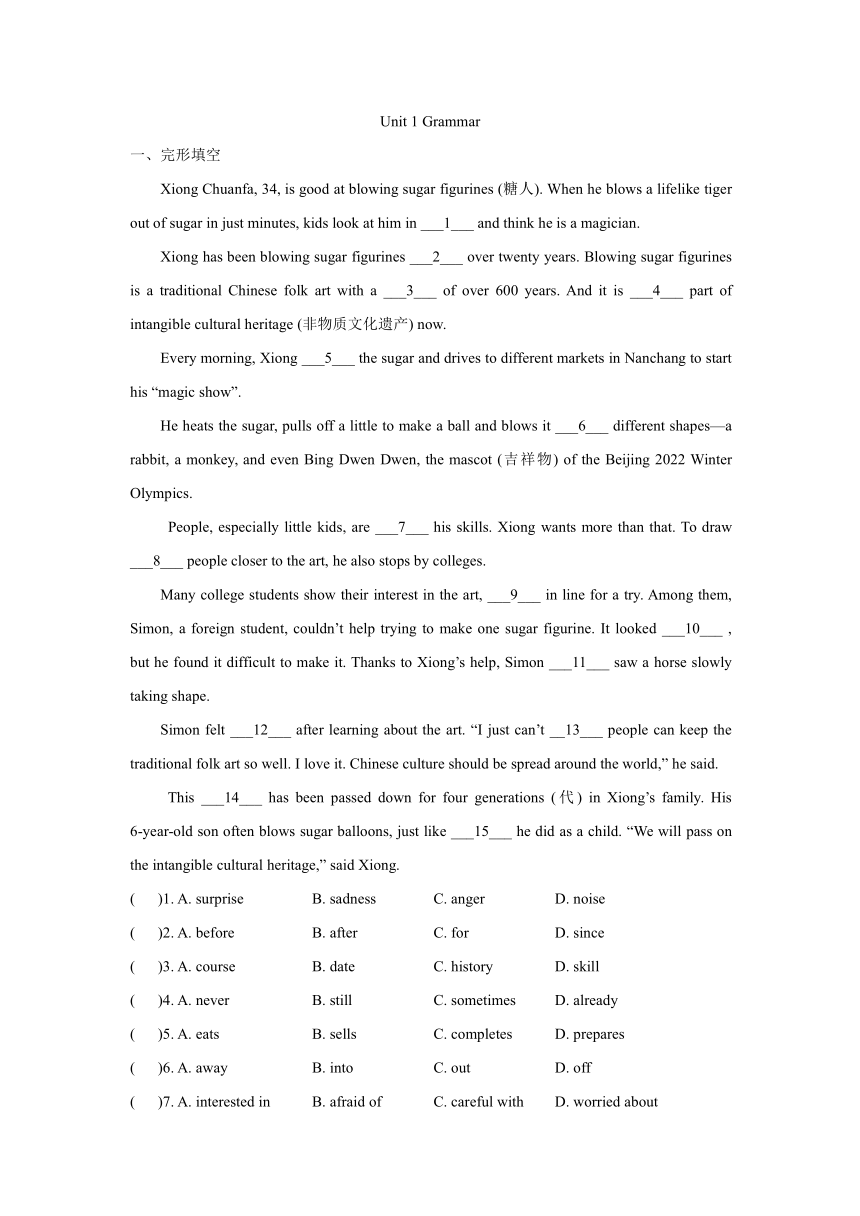
Unit 1 Grammar 一、完形填空 Xiong Chuanfa, 34, is good at blowing sugar figurines (糖人). When he blows a lifelike tiger out of sugar in just minutes, kids look at him in ___1___ and think he is a magician. Xiong has been blowing sugar figurines ___2___ over twenty years. Blowing sugar figurines is a traditional Chinese folk art with a ___3___ of over 600 years. And it is ___4___ part of intangible cultural heritage (非物质文化遗产) now. Every morning, Xiong ___5___ the sugar and drives to different markets in Nanchang to start his “magic show”. He heats the sugar, pulls off a little to make a ball and blows it ___6___ different shapes—a rabbit, a monkey, and even Bing Dwen Dwen, the mascot (吉祥物) of the Beijing 2022 Winter Olympics. People, especially little kids, are ___7___ his skills. Xiong wants more than that. To draw ___8___ people closer to the art, he also stops by colleges. Many college students show their interest in the art, ___9___ in line for a try. Among them, Simon, a foreign student, couldn’t help trying to make one sugar figurine. It looked ___10___ , but he found it difficult to make it. Thanks to Xiong’s help, Simon ___11___ saw a horse slowly taking shape. Simon felt ___12___ after learning about the art. “I just can’t __13___ people can keep the traditional folk art so well. I love it. Chinese culture should be spread around the world,” he said. This ___14___ has been passed down for four generations (代) in Xiong’s family. His 6-year-old son often blows sugar balloons, just like ___15___ he did as a child. “We will pass on the intangible cultural heritage,” said Xiong. ( )1. A. surprise B. sadness C. anger D. noise ( )2. A. before B. after C. for D. since ( )3. A. course B. date C. history D. skill ( )4. A. never B. still C. sometimes D. already ( )5. A. eats B. sells C. completes D. prepares ( )6. A. away B. into C. out D. off ( )7. A. interested in B. afraid of C. careful with D. worried about ( )8. A. old B. young C. rich D. poor ( )9. A. running B. jumping C. waiting D. laughing ( )10. A. serious B. clear C. delicious D. easy ( )11. A. quickly B. suddenly C. finally D. hurriedly ( )12. A. awful B. excited C. sad D. energetic ( )13. A. believe B. remember C. repeat D. understand ( )14. A. painting B. custom C. art D. knowledge ( )15. A. how B. when C. why D. what 二、阅读理解 At the opening ceremony of the Beijing 2008 Olympic Games, Tai Chi performers impressed the whole world. A total of 2,008 performers stood in a large circle and moved in slow, calm and powerful motions(动作)in their white silk uniforms. Tai Chi has always been a symbol of Chinese culture and is becoming popular around the world. This ancient martial art(武术)is practiced by over 100 million people in more than 150 countries. One thing that makes Tai Chi popular is its health benefits. As you move, you breathe deeply and naturally, focusing your attention—just as in some kinds of meditation(冥想)—on your body. This helps you relax and ... ...
~~ 您好,已阅读到文档的结尾了 ~~

